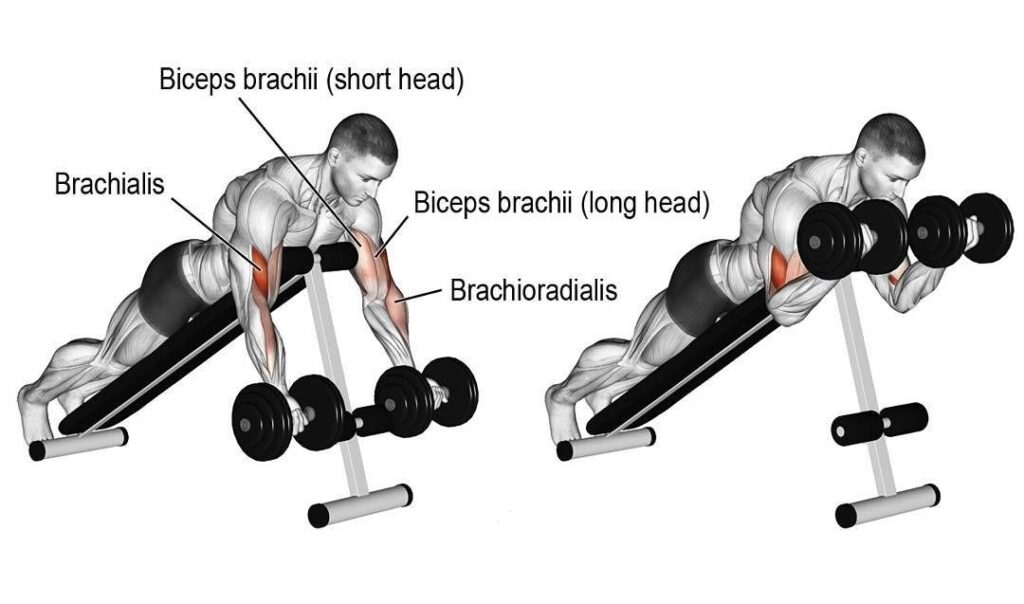What is a bicep spider curl?
The bicep spider curl is a resistance exercise that targets the bicep muscles in the upper arm. Whereas most curling exercises focus on the long head of the bicep, the dumbbell spider curl targets the inner, shorter head.
The longer, outer head may provide the bicep 'peak' that many bodybuilders chase, but the inner head gives the biceps a rounded look.
If you want to add size to your biceps and overall strength to your arms, include dumbbell spider curls in your routine. They are great to superset with incline dumbbell curls or drag curls for a fuller, rounder bicep.
Which muscles do spider curls target?
The primary target muscle is the short bicep head. Other muscles are involved with the motion, but the short head is the primary target and the main focus. The diagram below shows the secondary and stabiliser muscles that are also engaged.

As you can see from the diagram, dumbbell spider curls also activate muscles in the forearm making them a great exercise for upper arm growth and lower arm thickness.
By using the bench as a support, you do not need to worry about using your core or back muscles as stabilisers. Gravity makes sure that your arms stay in a fixed position so your shoulders are also kept out of the equation.
How to perform a dumbbell spider curl for bigger biceps
To perform spider curls you will need a sit-up bench or an incline dumbbell bench set to around 45 degrees and a pair of dumbbells. If you do not have dumbbells, you can use an EZ bar or a cable machine with an EZ bar attachment.
- Set your bench at 45-60 degrees and lay on your front with your arms hanging down. Pick up your dumbbells and hold them with your palms facing away from you.
- Take a deep breath and on exhale slowly curl the dumbbells towards your shoulders, keeping your upper arm in a fixed position.
- At the top of the motion, hold the dumbbells and squeeze the bicep for a couple of seconds before slowly lowering. the weight.
- Repeat for the required number of reps.
Be sure to use a light weight for this exercise and focus on a slow, controlled movement. It is a hard exercise to do with a heavy weight and the biceps tend to respond better to quality, low weight reps.
At the top of each movement, when you have curled the bar up and are holding the position, squeeze the bicep and try to feel the connection with the muscle.
By doing this and lowering the bar back down very slowly, you will be maximising time under tension and really fatiguing the biceps. This will, in turn, cause micro-tears in the muscle and force adaptation.
Spider curl vs. regular bicep curl
With the regular curl, you start with your arm at your side and then you curl until your elbow gets tight. You use the same muscle (the biceps) for the whole lift, which is good because it's doing the heavy lifting.
There's less potential for injury and less risk of overuse in the biceps muscle. Plus, people who are strong can lift more weight when using this exercise.
Spider curls are done by putting one hand supine and then bridging up and pulling under with the other arm; they don't require too much upper body stability so someone with bad shoulders or who is out of shape could do it as well.
They also work more muscles than just the biceps so you can work out more efficiently in less time (compared to regular curls).
In conclusion, if you are just trying to isolate the biceps for hypertrophy, spider curls are the best option. If you are looking to develop the biceps for endurance and strength, perhaps go heavier with some regular curls.
Variations to the spider curl
Cable spider curl
The cable spider curl is performed in the same way as the dumbbell spider curl but with the cable machine providing resistance. You will need to wheel the ab bench or incline dumbbell bench over to the cable machine and set the pin to a low starting point. It is easier to use an EZ bar attachment than a straight bar as it allows a neutral grip at full stretch.
As with the dumbbell curls, make sure you start with a low weight and are fully warmed up.
Barbell Spider curl
A barbell will be just as effective as a dumbbell or cables for a spider curl. It is advisable again to use an EZ bar as a straight bar may cause over-rotation of the wrists, especially if using a narrow grip.
Simply follow the steps for the dumbbell curl as listed above, but use the barbell for resistance instead.
Advantages of spider curls
Spider curls are great for building a fuller, rounder bicep. The bicep is under tension throughout the movement and is fully stretched allowing for a great range of motion.
The other advantage is the pump! By lying on your front and hanging your shoulders over the edge, you are restricting the blood flow to your arms, allowing for a great pump. This makes the spider curl a great finisher for your bicep routine.
Conclusion
We can conclude that spider curls are a great movement for developing the biceps and forearms by hitting them from an angle that not many other bicep exercises do. Adding variety to your arm training with spider curls, drag curls and reverse grip curls is a great way to promote hypertrophy and get the maximum gains.
We hope that you have found this article informative. If you are looking for a FREE hypertrophy bodybuilding program, check out our HyperGrowth training strategy. It is a scientifically-backed training split that places emphasis on high-frequency training for muscles that recover quickly. Click here to view the free HyperGrowth training split.

